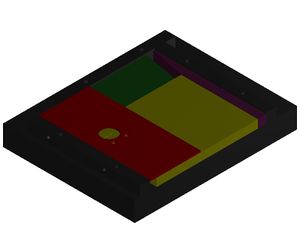Calibration Device for Scintillators
Revision as of 19:44, 11 November 2010 by Jturner (talk | contribs) (Created page with '== Tools == thumb|Work Stand Apparatus * We designed our own apparatus to cut, polish, and glue the scintillators and the waveguides. For more …')
Tools
- We designed our own apparatus to cut, polish, and glue the scintillators and the waveguides. For more information on how it works, see Work Stand Assembly.
- To cut the fibers I use a standard hobby knife.
- For cleaning and polishing acrylic fibers, the recommended tool to use is a plastic nail buff.
- A digital scale (accurate to ±0.01 grams) is used to weigh out the proper proportions of the resin and catalyst.
- Standard laboratory glassware is used for weighing, mixing, and applying the epoxy.
- A laboratory hotplate is used to heat-cure the epoxy.
- An infrared thermometer is used for calibrating the hotplate temperature controls.
For more information (such as prices and product numbers) on the equipment listed above see Supplies
Fiber Research
Fiber Width Variation
To make acrylic optical fibers, Bicron uses the stretch method which involves stretching a mass of material into a long fiber of a specific diameter or width in our case. As a result of this process, there develops minor variations in width along the stretched fiber. Since minor variations in width can compound in to a significant misalignment, I have measured the width distribution of 30 fibers cleaved from the same fiber spool. Below is a histogram of the widths and a plot of the x-axis width vs. the y-axis.
